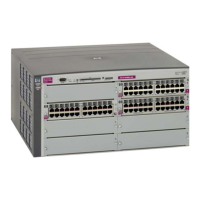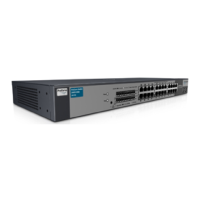Routing Information Protocol 95
RIPv2 in RIPv1 compatibility mode
GbE2c software allows you to configure RIPv2 in RIPv1compatibility mode, for using both RIPv2 and RIPv1 routers
within a network. In this mode, the regular routing updates use broadcast UDP data packet to allow RIPv1 routers to
receive those packets. With RIPv1 routers as recipients, the routing updates have to carry natural or host mask.
Hence, it is not a recommended configuration for most network topologies.
NOTE: When using both RIPv1 and RIPv2 within a network, use a single subnet mask throughout the network.
RIP Features
GbE2c software provides the following features to support RIPv1 and RIPv2:
Poison
Simple split horizon in RIP scheme omits routes learned from one neighbor in updates sent to that neighbor. That is the
most common configuration used in RIP that is setting this Poison to disable. Split horizon with poisoned reverse
includes such routes in updates, but sets their metrics to 16. The disadvantage of using this feature is the increase of
size in the routing updates.
Triggered updates
Triggered updates are an attempt to speed up convergence. When Triggered Updates is enabled
(/cfg/l3/rip/if x/trigg ena), whenever a router changes the metric for a route, it sends update messages
almost immediately, without waiting for the regular update interval. It is recommended to enable Triggered Updates.
Multicast
RIPv2 messages use IP multicast address (224.0.0.9) for periodic broadcasts. Multicast RIPv2 announcements are not
processed by RIPv1 routers. IGMP is not needed since these are inter-router messages which are not forwarded.
To configure RIPv2 in RIPv1-compatibility mode, set multicast to disable.
Default
The RIP router can listen and supply a default route, usually represented as 0.0.0.0 in the routing table. When a
router does not have an explicit route to a destination network in its routing table, it uses the default route to forward
those packets.
Metric
The metric field contains a configurable value between 1 and 15 (inclusive) which specifies the current metric for the
interface. The metric value typically indicates the total number of hops to the destination. The metric value of 16
represents an unreachable destination.
Authentication
RIPv2 authentication uses plaintext password for authentication. If configured using Authentication password, then it is
necessary to enter an authentication key value.
The following method is used to authenticate a RIP message:
• If the router is not configured to authenticate RIPv2 messages, then RIPv1 and unauthenticated RIPv2 messages
are accepted; authenticated RIPv2 messages are discarded.
• If the router is configured to authenticate RIPv2 messages, then RIPv1 messages and RIPv2 messages which pass
authentication testing are accepted; unauthenticated and failed authentication RIPv2 messages are discarded.
For maximum security, RIPv1 messages are ignored when authentication is enabled (cfg/l3/rip/if x/auth
password); otherwise, the routing information from authenticated messages is propagated by RIPv1 routers in an
unauthenticated manner.
